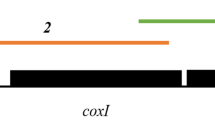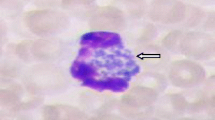Abstract
Molecular detection of apicomplexan parasites in splenic samples of red foxes collected from northeastern Poland was conducted by PCR amplification of a fragment of the 18S rRNA spanning the V4 gene region of Apicomplexa. Positive PCR products were further analysed by restriction fragment length polymorphism (RFLP) and sequencing to identify species. One hundred and eleven red foxes (Vulpes vulpes) were acquired from 15 localities in the Mazovian Province and 27 foxes were acquired from the Mazurian Lakeland. Apicomplexan 18S rDNA was detected in 15.9% of 138 fox spleens examined. Three apicomplexan species were identified: Hepatozoon canis was detected in 11.6% of the spleen samples, Toxoplasma gondii was detected in 3.6% of the spleen samples and a Babesia sp. was sequenced from 1 sample (0.7%). This data represent the first record of H. canis, T. gondii and a B. sp. from naturally infected red foxes in Poland. Infected foxes may act as sylvatic reservoirs of these apicomplexan parasites as well as serving as a source of infection for arthropod definitive hosts and vectors.
Similar content being viewed by others
References
Adaszek Ł., Winiarczyk S. 2008. Molecular characterisation of Babesia canis canis isolates from naturally infected dogs in Poland. Veterinary Parasitology, 152, 235–241. DOI: 10.1016/j.vetpar.2007.12.024.
Alencar N.X., Kohayagawa A., Santarém V.A. 1997. Hepatozoon canis infection of wild carnivores in Brazil. Veterinary Parasitology, 70, 279–282. DOI: 10.1016/S0304-4017(96)01119-3.
Antolová D., Reiterová K., Miterpáková M., Stanko M., Dubinský P. 2004. Circulation of Toxocara spp. in suburban and rural ecosystems in the Slovak Republic. Veterinary Parasitology, 126, 317–324. DOI: 10.1016/j.vetpar.2004.08.005.
Birkenheuer A.J., Levy M.G., Breitschwerdt E.B. 2003. Development and evaluation of a seminested PCR for detection and differentiation of Babesia gibsoni (Asian genotype) and B. canis DNA in canine blood samples. Journal of Clinical Microbiology, 41, 4172–4177. DOI: 10.1128/JCM.41.9.4172-4177.2003.
Cacciò S.M., Antunovic B., Moretti A., Mangili V., Marinculic A., Baric R.R., Slemenda S.B., Pieniazek N.J. 2002. Molecular characterisation of Babesia canis canis and Babesia canis vogeli from naturally infected European dogs. Veterinary Parasitology, 106, 285–292. DOI: 10.1016/S0304-4017(02)00112-7.
Camacho A.T., Pallas E., Gestal J.J., Guitián F.J., Olmeda A.S., Goethert H.K., Telford S.R. 2001. Infection of dogs in northwest Spain with a Babesia microti-like agent. Veterinary Record, 149, 552–555.
Conceicão-Silva F.M., Abranches P., Silva-Pereira M.C., Janz J.G. 1988. Hepatozoonosis in foxes from Portugal. Journal of Wildlife Diseases, 24, 344–347.
Criado-Fornelio A., Martinez-Marcos A., Buling-Saraña A., Barba-Carretero J.C. 2003. Molecular studies on Babesia, Theileria and Hepatozoon in southern Europe*1: Part I. Epizootiological aspects. Veterinary Parasitology, 113, 189–201. DOI: 10.1016/S0304-4017(03)00078-5.
Criado-Fornelio A., Rey-Valeiron C., Buling A., Barba-Carretero J.C., Jefferies R., Irwin P. 2007. New advances in molecular epizootiology of canine hematic protozoa from Venezuela, Thailand and Spain. Veterinary Parasitology, 144, 261–269. DOI: 10.1016/j.vetpar.2006.09.042.
Davis D.S., Robinson R.M., Craig T.M.J. 1978. Naturally occurring hepatozoonosis in a coyote. Journal of Wildlife Diseases, 14, 244–246.
Dubinský P., Malczewski A., Miterpáková M., Gawor J., Reiterová K. 2006. Echinococcus multilocularis in the red fox Vulpes vulpes from the East Carpathian region of Poland and the Slovak Republic. Journal of Helminthology, 80, 243–247. DOI: 10.1079/JOH2006354.
Ewing S.A., Panciera R.J. 2003. American canine hepatozoonosis. Clinical Microbiology Reviews, 16, 688–697. DOI: 10.1128/CMR.16.4.688-697.2003.
Ewing S.A., Panciera R.J., Mathew J.S., Cummings C.A., Kocan A.A. 2000. American canine hepatozoonosis. An emerging disease in the New World. Annals of the New York Academy of Sciences, 916, 81–92.
Fishman Z., Gonena L., Harrus S., Strauss-Ayali D., King R., Baneth G. 2004. A serosurvey of Hepatozoon canis and Ehrlichia canis antibodies in wild red foxes (Vulpes vulpes) from Israel. Veterinary Parasitology, 119, 21–26. DOI: 10.1016/j.vetpar.2003.08.012.
Forlano M.D., Teixeira K.R.S., Scofield A., Elisei C., Yotoko K.S.C., Fernandes K.R., Linhares G.F.C., Ewing S.A., Massard C.L. 2007. Molecular characterization of Hepatozoon sp. from Brazilian dogs and its phylogenetic relationship with other Hepatozoon spp. Veterinary Parasitology, 145, 21–30. DOI: 10.1016/j.vetpar.2006.10.023.
Garrett J.J., Kocan A.A., Reichard M.V., Panciera R.P., Bahr R.J., Ewing S.A. 2005. Experimental infection of adult and juvenile coyotes with domestic dog and wild coyote isolates of Hepatozoon americanum (Apicomplexa: Adeleorina). Journal of Wildlife Diseases, 41, 588–592.
Gawor J., Malczewski A., Stefaniak J., Nahorski W., Paul M., Kacprzak E., Myjak P. 2004. Zagrożenie bąblowicą ielojamową (alweokokozą) dla ludzi w Polsce. Przegląd Epidemiologiczny, 58, 459–465.
Goszczyński J., Misiorowska M., Juszko S. 2008. Changes in the density and spatial distribution of red fox dens and cub numbers in central Poland following rabies vaccination. Acta Theriologica, 53, 121–127.
Gubbels J.M., Vos A.P., Weide M., Viseras J., Schouls L.M., Vries E., Jongejan F. 1999. Simultaneous detection of bovine Theileria and Babesia species by reverse line blot hybridization. Journal of Clinical Microbiology, 37, 1782–1789.
Heerden J., Mills M.G., Vuuren M.J., Kelly P.J., Dreyer M.J. 1995. An investigation into the health status and diseases of wild dogs (Lycaon pictus) in the Kruger National Park. Journal of the South African Veterinary Association, 66, 18–27.
Hůrková L., Modrý D. 2006. PCR detection of Neospora caninum, Toxoplasma gondii and Encephalitozoon cuniculi in brains of wild carnivores. Veterinary Parasitology, 15, 150–154. DOI: 10.1016/j.vetpar.2006.01.005.
Jittapalapong S., Rungphisutthipongse O., Maruyama S., Schaefer J.J., Stich R.W. 2006. Detection of Hepatozoon canis in stray dogs and cats in Bangkok, Thailand. Annals of the New York Academy of Sciences, 1081, 479–488. DOI: 10.1196/annals.1373.071.
Kocan A.A., Breshears M.A., Panciera R.J., Ewing S.A., Barker R.W. 1999. Naturally occurring hepatozoonosis in coyotes from Oklahoma. Journal of Wildlife Diseases 35, 86–89.
Maede Y., Ohsugi T., Ohotaishi N. 1982. Hepatozoon infection in wild fox (Vulpes vulpes schrencki Kishida) in Japan. Japanese Journal of Veterinary Science, 44, 137–142.
Majláthová V., Hurníková Z., Majláth I., Pet’ko B. 2007. Hepatozoon canis infection in Slovakia: imported or autochthonous? Vector-Borne and Zoonotic Diseases, 7, 199–202. DOI: 10.1089/vbz.2006.0598.
Majláthová V., Majláth I., Derdáková M., Víchová B., Pet’ko B. 2006. Borrelia lusitaniae and green lizards (Lacerta viridis), Karst Region, Slovakia. Emerging Infectious Diseases, 12, 1895–1901.
Panek M., Bresiński W. 2002. Red fox Vulpes vulpes density and habitat use in a rural area of western Poland in the end of 1990s, compared with the turn of 1970s. Acta Theriologica, 47, 433–442.
Prestrud K.W., Dubey J.P., Asbakk K., Fuglei E., Su C. 2008. First isolate of Toxoplasma gondii from arctic fox (Vulpes lagopus) from Svalbard. Veterinary Parasitology, 151, 110–114. DOI: 10.1016/j.vetpar.2007.11.011.
Shamir M., Yakobson B., Baneth G., King R., Dar-Verker S., Markovics A., Arochm I. 2001. Antibodies to selected canine pathogens and infestation with intestinal helminths in golden jackals (Canis aureus) in Israel. Veterinary Journal, 162, 66–72. DOI: 10.1053/tvjl.2000.0572.
Siuda K. 1993. Kleszcze Polski (Acari: Ixodida). II. Systematyka i rozmieszczenie. Polskie Towarzystwo Parazytologiczne, Warsaw, 381 pp.
Zahler M., Rinder H., Schein E., Gothe R. 2000. Detection of a new pathogenic Babesia microti-like species in dogs. Veterinary Parasitology, 89, 241–248. DOI: 10.1016/S0304-4017(00)00202-8.
Author information
Authors and Affiliations
Corresponding author
Rights and permissions
About this article
Cite this article
Karbowiak, G., Majláthová, V., Hapunik, J. et al. Apicomplexan parasites of red foxes (Vulpes vulpes) in northeastern Poland. Acta Parasit. 55, 210–214 (2010). https://doi.org/10.2478/s11686-010-0030-6
Accepted:
Published:
Issue Date:
DOI: https://doi.org/10.2478/s11686-010-0030-6




